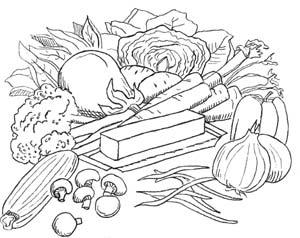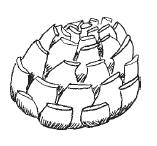Nourishing Traditions: The Cookbook That Challenges Politically Correct Nutrition and The... (102 page)
Authors: Sally Fallon,Pat Connolly,Phd. Mary G. Enig
Tags: #Non-Fiction, #Reference, #Science, #Health

The American love affair with fast food is almost incomprehensible considering the great variety of fresh vegetables now available year round in every American town. Relatively few take advantage of this cornucopia. Most Americans eat vegetables rarely, and when they do their choices are confined to a few favorites—carrots, peas, tomatoes and potatoes. Yet fresh vegetables can be the highlight of every meal. Few of them require much time to prepare, and most need very little time to cook. Furthermore, almost every vegetable that has been studied has been found to contain substances that benefit the heart and blood or counteract the formation of tumors. Fresh vegetables, eaten with the right fats on a daily basis, are one of our best protections against coronary heart disease and cancer.
Steaming is the best way to cook most vegetables. This preserves most vitamins and minerals and a good many enzymes as well, if the process is not allowed to continue too long. Light sauteing in butter, olive oil or coconut oil is also an acceptable cooking method. Some research indicates that cooking foods in fats and oils actually makes nutrients more available. Other methods include blanching in boiling filtered water and, for root vegetables, cooking in a clay pot.
While we recommend the inclusion of much raw food in the diet, some vegetables are best eaten cooked. For example, cabbage, broccoli, Brussels sprouts and kale contain chemicals that block the production of thyroid hormone (known medically as goitrogens). Beet greens, spinach and chard contain oxalic acid that blocks calcium and iron absorption and irritates the mouth and intestinal tract. Raw potatoes contain substances called hemagglutinins that disrupt the proper function of red blood cells. Cooking destroys or neutralizes these harmful substances (as does the fermentation process). Spinach and cabbage are popular salad foods but should be eaten raw only occasionally.
It may sound like heresy, but we do not recommend saving vegetable cooking water. Adelle Davis was the first popular nutrition writer to suggest reusing cooking water, on the premise that vitamins and minerals lost from vegetables during cooking end up in the water. This may well be true, but unfortunately a lot of other things end up in the water as well—pesticides and nitrites from commercially grown produce along with many of the harmful compounds listed above, particularly oxalic acid. The solution is to steam lightly and not very long. Most of the vitamins and minerals will remain in the vegetables where they belong, and the small loss will be compensated by the fact that light cooking makes the nutrients in vegetables more readily available and assimilated.
There are several broad categories of vegetables. First are the dark green, leafy vegetables, such as spinach, chard and beet greens. These contain abundant vitamins and minerals, particularly B vitamins, calcium and trace minerals, and should be included in the diet on a regular basis—at least once or twice a week. A second category is the cruciferous vegetables—cabbage, chard, Brussels sprouts, cauliflower and broccoli—which contain natural chemicals shown to block the formation of tumors in the digestive tract. Other categories are tubers (potatoes and sweet potatoes), root vegetables (carrots, turnips, parsnips and beets), the squash family (including zucchini), the lily family (onions, leeks and garlic) and the nightshade family (tomatoes, eggplant and peppers).
While all vegetables contain good things, we must once again caution that our choice of vegetables must take into account individual food sensitivities. Vegetables from the nightshade family may cause arthritis and painful joints in sensitive individuals. The cruciferous vegetables have been in the spotlight recently, but they are not for everybody—their high sulphur content may cause problems for some. Vegetables from the onion family tend to stimulate the glands and should therefore be avoided by those suffering from fatigue or weak adrenal function. Almost any vegetable can cause adverse and allergic reactions if eaten to excess—that is why variety is so important.
The most important piece of equipment you will need for vegetable preparation is a two-part, stainless steel steamer—like a double boiler with holes in the bottom of the upper pan. A wooden cutting board, a heavy stainless steel or cast-iron frying pan and a collection of sharp knives complete the list of items necessary for successful vegetable preparation. A clay pot is also useful—potatoes are delicious cooked this way.
Frozen vegetables are acceptable on occasion, but most of the vegetables you eat should be fresh and, if possible, organically or biodynamically grown. All commercial vegetables should be washed in water with a little Clorox bleach, hydrogen peroxide or Dr. Bronner's Sal Suds (see
Kitchen Tips and Hints
), and then thoroughly rinsed to remove chemical residues.
Dark green, leafy vegetables tend to concentrate nitrites when commercially grown with high-nitrogen fertilizer. In the intestinal tract these nitrates may be transformed into potent carcinogens. Nitrates also tend to form in cooked vegetables during storage; for this reason we caution you against eating reheated vegetables, particularly green vegetables.
Don't hesitate to put butter on your steamed vegetables. The fat-soluble vitamins and the Price Factor in butter are just what your body needs to fully utilize minerals in plant foods. Season vegetables lightly after cooking with sea salt.
ARTICHOKES
Cut the stems off the artichokes and place with leaves up in a vegetable steamer or in a large pot containing about 1 inch of filtered water. Steam, covered, until tender, about ½ hour. Remove with tongs and place artichokes, leaves down, in a colander to drain. Remove the outermost leaves and serve warm or cold with
basic dressing
,
herbed mayonnaise
or
lemon butter sauce
.
Stuffed Artichokes
Serves 44 artichokes
½ cup extra virgin olive oil or ½ cup melted butter
4 cloves garlic, peeled and mashed
2 cups whole grain bread
sea salt and pepper
Steam artichokes in a vegetable steamer as described above until just barely tender. Mix olive oil with garlic and bread crumbs and season to taste. Pull artichoke leaves open a bit and use scissors to snip points off leaves. Press stuffing down between leaves. Return to steamer for another 5 to 10 minutes. These are messy to eat but delicious.
The artichoke is of Arabic origin—called
al-kharshuf
in the Middle East—which comes to us by way of Italy. Like all members of the thistle family, artichokes concentrate iodine when it is in the soil. Research indicates that the artichoke can benefit the intestinal tract and the heart; it has been shown to reduce blood clotting time and to neutralize certain toxic substances. Studies in Japan and Switzerland show that artichokes can lower blood cholesterol. In fact, a constituent of artichoke called cynarin has been formulated into a cholesterol-lowering drug. Folk wisdom values the artichoke as a stimulant to the bile. Artichokes are in season in the spring. Choose artichokes that seem heavy for their size and whose leaves are more or less free from dark streaks. SWF

ASPARAGUS
Trim off the tough ends and rinse well. If asparagus is of large diameter, you may want to pare off about an inch of green from the ends. Place in a vegetable steamer and steam about 5 minutes until stalks turn bright green and can be pierced easily with a fork. Don't overcook! Transfer to a heated serving dish, place a generous pat of butter on top and finish with a squeeze of lemon juice. May be kept warm in the oven for about ½ hour.
Asparagus with Sesame Seeds
Serves 6
2 ½ pounds asparagus, trimmed
2 tablespoons extra virgin olive oil or melted butter
2 tablespoons shallots, minced
2 tablespoons sesame seeds, lightly toasted
juice of 1 lemon
sea salt
Place oil and asparagus in a glass baking dish and toss so that the asparagus is completely coated with oil. Bake at 400 degrees for about 8 minutes, shaking the dish every two minutes or so. Sprinkle on the shallots and sesame seeds and bake, with one or two shakes, for 1 minute more. Transfer to heated serving bowl and squeeze on lemon juice. Season to taste.
Asparagus is an Italian vegetable that dates from the Renaissance. Much prized in Europe, asparagus dishes are featured in fine restaurants during the peak season—May and June. One restaurant in Germany lists 209 separate asparagus dishes on its menu!
Asparagus is a good source of rutin, a substance that prevents small blood vessels from breaking. Medieval medicine valued asparagus for the treatment of heart palpitations and as a diuretic. Asparagus is high in carotenoids, B Complex, vitamin C and vitamin E as well as potassium, iodine and zinc.
Asparagus must be fresh to be good. Check the tips to see that the little buds are distinct; if the tips have gone mushy, the asparagus is not worth buying. SWF

BEANS, FRENCH
These slender, tender beans are new in American markets and still too expensive for everyday dinner fare; but they are worth buying for special meals, as they make a beautiful addition to the plate. Best time to buy is late summer, when they are in season locally and have not been shipped long distances.
Snip off both ends. French beans can be steamed in a vegetable steamer, but better results are obtained from blanching. Bring a pot of salted filtered water to boil. Plunge in beans and cook rapidly for about 8 minutes, until they are tender. Pour beans into a colander and rinse with cold water. This will bring out an intense green color. Transfer to a heated serving dish and top with a generous pat of butter. Place in a warm oven to restore heat—they may be kept there for up to ½ hour before serving.
Strawberries lead the list of the thirteen most contaminated fruits and vegetables sold in American supermarkets. According to a 1993 Environmental Working Group study, on some farms strawberries are sprayed with 500 pounds of pesticides per acre. Red and green bell peppers come next, which are high in neurotoxic residues. Other highly contaminated foods include spinach, cherries, peaches, Mexican cantaloupe, celery, apples, apricots, green beans, Chilean grapes and cucumbers.
Fruits and vegetables from foreign countries are subject to even less stringent regulations than domestic varieties. Imported bananas, for example, often are treated with benomyl (linked to birth defects) and chlorpyrifos (a neurotoxin).
Among grains, rice and oats were found to be the most contaminated.
The solution? Buy organic, especially when it comes to the popular fruits and vegetables listed above. Even better, buy biodynamic, which is an all-natural farming technique developed by Rudolf Steiner, the multifaceted Austrian mystic and philosopher. In the U.S., biodynamic standards are higher than organic standards. Biodynamic crops are nourished with naturally composted manure from cows allowed to graze freely.
Many varieties of commercial fruits rot before they ripen—a sign of nutrient deficiencies. Fruits and vegetables from properly nourished soil, on the other hand, have good ripening and keeping qualities. They may cost a bit more, but the long-term benefits include personal good health and an economy in which the wealth is spread among thousands of independent farmers, rather than concentrated in the hands of a few multinational corporations. SWF